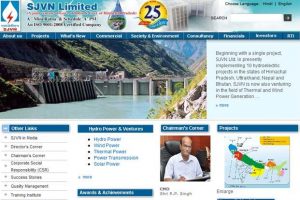Project development agreement for the 5900MW project submitted to Nepal by Satluj Jal Vidyut Nigam 2 years ago yet to be signed
 New Delhi: Satluj Jal Vidyut Nigam Ltd’s (SJVNL) Arun-III project in Nepal has hit the skids with a key agreement for the 900 megawatts (MW) project awarded in 2008 yet to be signed.
New Delhi: Satluj Jal Vidyut Nigam Ltd’s (SJVNL) Arun-III project in Nepal has hit the skids with a key agreement for the 900 megawatts (MW) project awarded in 2008 yet to be signed.
The Indian state-run company submitted a project development agreement (PDA) for the planned Rs.5,200-crore facility to the Nepal government two years ago, but despite several attempts from India it has not moved forward.
The hydropower project is to come up in Nepal’s Sankhuwasabha district.
India recently lost development rights for two hydropower projects in Myanmar because of environmental and social concerns.
Nepal is located strategically between India and China, both of which have significant regional and global aspirations. The Himalayan country is open to partnering with Chinese and Indian firms to raise money.
“While the draft for PDA was submitted around two years back, it hasn’t been signed. They (Nepal) are suspicious,” said an official in India’s power ministry, requesting anonymity. “This when the project was awarded after a competitive bidding. Since the PDA hasn’t been signed, further work is awaited.”
The project is still alive, he said, but “it is getting no traction”.
SJVNL and the Nepal government were to have signed the PDA by 16 January 2010, according to the Central Electricity Authority (CEA), India’s apex power sector planning body.
A memorandum of understanding (MoU) was signed between the Indian firm and the Nepal government on 2 March 2008.
As per New Delhi’s economic diplomacy initiative to engage Nepal, SJVNL is to provide 21.9% of the electricity generated from the project free to Nepal. It would also have to pay 7.5% of the total income from the project as royalty to the Nepal government. India, in turn, plans to transmit the electricity generated from the project to cater to the growing demand back home.
The build, own, operate and transfer project was awarded to SJVNL for 30 years.
A detailed project report for Arun-III submitted by SJVNL to CEA in May 2011 is under consideration.
According to the terms of the MoU, “SJVN shall be held responsible for the completion of the construction works within sixty (60) months from the date of financial closure to commissioning of the project.”
R.P. Singh, chairman and managing director, SJVNL, said there was no fear of losing the project.
“Now the project is moving. The PDA discussions are on. It is right that the PDA was submitted around two years back. What can we do, this is the way with Nepal, who are our partners on the project,” he said. “I am quite sure that the way that the negotiations are on with the investment board of Nepal, it will be sorted out.”
Hydropower projects come with their own set of problems. Executing such projects is a time-consuming and tedious process and their construction requires specialized technology and design.
An Indian foreign ministry spokesperson declined comment but referred questions to SJVNL. Questions emailed to the Nepal embassy in New Delhi on Monday remained unanswered till press time.
India has a power generation capacity of 225,133MW, of which 17.6% or 39,623.40MW is hydropower. In comparison, Nepal has an installed power generation capacity of 617MW, of which around 570MW is generated from hydropower.
Although Nepal has a hydropower potential of 43,000MW, known to be technically feasible and economically viable, it is facing a shortage, with India being a net exporter of power to Nepal.
Tapping some of the country’s hydropower potential could help bridge that gap and serve as a source of power for India. Nepal has emerged as a favourite destination for several Indian hydroelectric power generation firms.
Shiv Mukherjee, former Indian ambassador to Nepal, said: “Hydroelectric power and its potential has been highly politicized in Nepal. I won’t comment on specifics because I don’t know all the details. Nepal has among the highest viable hydropower potential but it still remains among the poorest nations because it is politicized. Instead of utilizing the potential, it remains muddled in power politics so much so that India exports electricity to Nepal.”
India has been trying to engage with its neighbours through participation in infrastructure projects.
Elizabeth Roche contributed to this story.
Source : Live Mint

No comments:
Post a Comment